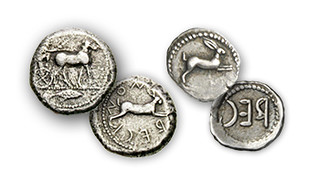
PREV ARTICLE
NEXT ARTICLE
FULL ISSUE
PREV FULL ISSUE
RABBITS & HARES ON ANCIENT COINS
I didn't manage to get this one in last week but wanted to recommend this article by Mike Markowitz in the CoinWeek Ancient
Coin Series. Published August 19, 2015, it covers the interesting and unusual topic of Bunny Money: Rabbits & Hares on Ancient
Coins. Here's an excerpt. -Editor

Many ancient Greek cities adopted symbolic or mythical animals as badges or totems. Athens chose the owl due to its association with Athena. Corinth chose the Pegasus. For Cyzicus in Anatolia, it was the tuna fish. And so on. Americans have a similar custom: the dolphin for Miami, the colt for Indianapolis, the bear for Chicago. Several cities in “Magna Graecia” (the region of southern Italy and Sicily settled by Greek colonists beginning in the eighth century BCE) adopted the leaping hare as a distinctive symbol on their classical-era coinage.
When his mule-chariot (biga) team won in the Olympic games, he placed that image on his coins. Coinage is conservative, and this basic design – mule chariot obverse, leaping hare reverse – was continued for generations.
To read the complete article, see:
Wayne Homren, Editor The Numismatic Bibliomania Society is a non-profit organization promoting numismatic literature. See our web site at coinbooks.org. To submit items for publication in The E-Sylum, write to the Editor at this address: whomren@gmail.com To subscribe go to: https://my.binhost.com/lists/listinfo/esylum All Rights Reserved. NBS Home Page Contact the NBS webmaster 
|

